The Moorhead Environmental Complex: Sharing Stroud Science Starts Here
By Diane Huskinson
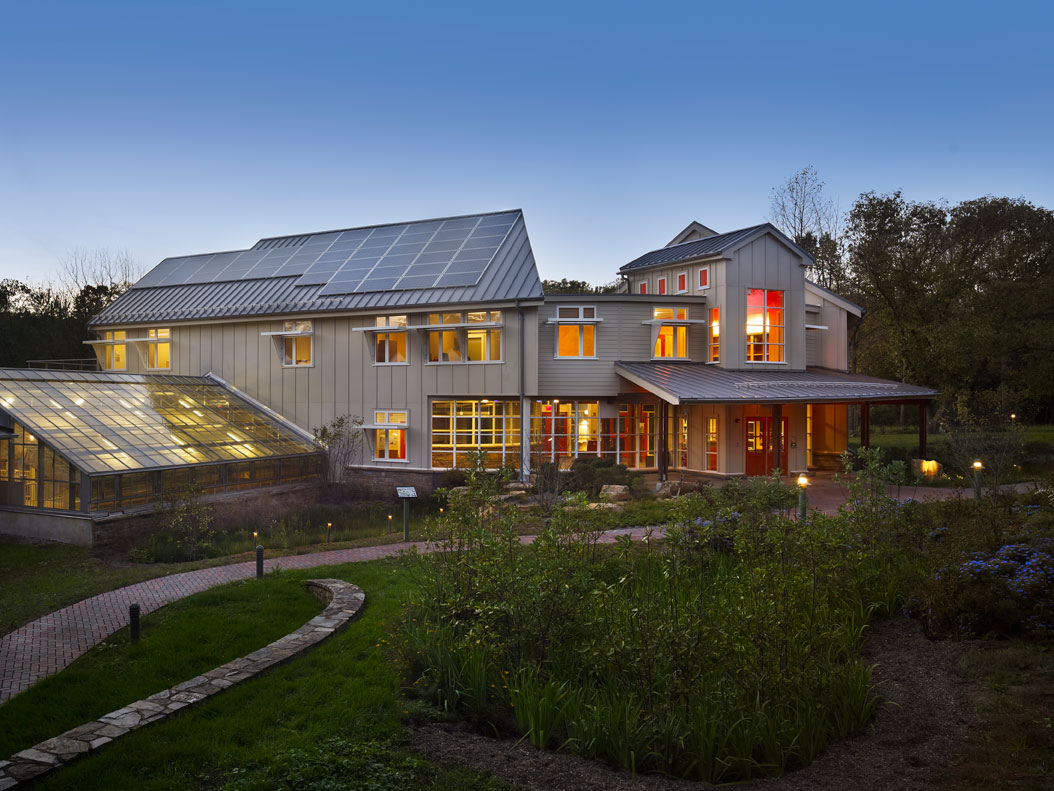
SMART GROWTH
Nestled in the backwoods of rural Avondale, Pa. along the babbling White Clay Creek is Stroud Water Research Center’s headquarters. Here scientists and educators are inspired by their natural surroundings as they seek to discover and share knowledge of freshwater streams and rivers.
Their inspired creativity and smart science have led to groundbreaking research and much-needed one-of-a-kind environmental education programs. However, continued success has required steady growth and, in turn, the hum and hammer of construction crews.
Scientists need laboratories and educators, classrooms, so when the Center most recently outgrew its facilities, which have been expanded and renovated several times since its founding in 1967, it was an opportunity to add more than just space.
In October 2010, Stroud Water Research Center broke ground on a new building for environmental education and public outreach that would model sustainable practices for managing water. The plan was to create a LEED-certified building and surrounding site that incorporated an array of green features, including bioswales, rain gardens, permeable surfaces, native landscaping, solar panels, a green roof, composting toilets, a rooftop rainwater capture system, and more (you can read more about the green features here) — all to meet the challenge of “Getting the Water Right.”
A DREAM REALIZED
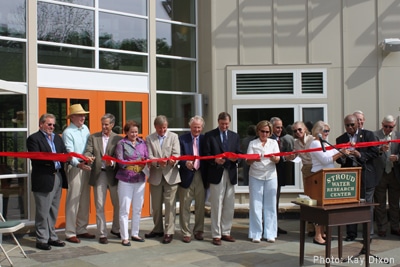
Thanks to the efforts of a talented design/build team and the generous support of many, the challenge was met, and on May 30, 2012, members of the board of directors cut the ribbon on the Moorhead Environmental Complex, named in honor of Board Co-chairman Rodman W. Moorhead III.
As he welcomed more than 300 friends and supporters of the Stroud Center at the dedication ceremony, Director Bern Sweeney said, “This new environmental complex is a physical reminder of our success. Although our program today still involves a concentrated effort on White Clay Creek (which flows behind you) and other streams in this region, our science and education programs have now expanded to hundreds of other streams, rivers, and watersheds spanning all the continents on Earth.”
It’s true. Today, tropical research, such as that conducted out of the Maritza Biological Station, as well as education programs like Leaf Pack, play a key role in the Stroud Center’s global efforts to advance knowledge and stewardship of fresh water.
With the additional space the Moorhead Environmental Complex provides, the Education Department now has two new classrooms, more work space, and its very own home — a home that will be a beacon that reaches well beyond its walls. Education along with communications, development, and other teams now housed in the Complex, will work together under one roof to share environmental science with the public.
The Complex stands alone as a research and teaching tool. Green features like the wetland waste treatment and roof rainwater capture systems are on the cutting edge of design that works in harmony with nature and will provide ample opportunity for Stroud Center scientists to study their effectiveness and for educators to use as an illustration of Earth’s hydrological cycle.
FRIENDS LIKE YOU
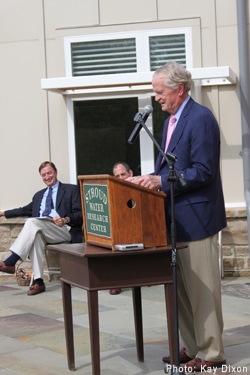
“We wanted a building that manifested our values, that would be a teaching tool for our educators, and that would provide research opportunities for our staff,” said Moorhead during his address to the crowd.
Moorhead’s longtime support of the Center and his leading contribution to the capital campaign have helped make the Complex and executing the Center’s mission possible.
Sweeney acknowledged Moorhead’s invaluable support: “He has provided the business leadership that has helped catapult the … Center to the top in the past few decades. He viewed our mission of advancing knowledge and stewardship of fresh water through research and education as a business.”
Also present were Secretary Michael Krancer of the Pennsylvania Department of Environmental Protection, which awarded the Center a grant of more than $239,000 toward the wetland waste treatment and roof rainwater capture systems; Pennsylvania State Rep. Chris Ross; Chester County Commissioner Terence Farrel; and representatives from West Marlboro Township.
Because of Moorhead and others like him, the Stroud Center has raised in cash and pledges more than 70 percent of the capital campaign’s $11.6 million goal. That goal includes initiatives that are more than just bricks and mortar. In addition, it covers endowment that will support the Stroud Center’s tropical research initiative and two critical leadership positions: the assistant director and director of education positions are essential to administering expanding research capabilities and broadening the Stroud Center’s reach and influence.
Director of Education Susan Gill commented, “We’re here to serve our community and others around the world. Though we face many challenges, especially related to water, the future is exciting. Our science and education are constantly evolving, and what we learn and share is an investment in innovative solutions. The students who come here to identify insects and collect leaf litter are tomorrow’s scientists, engineers, and legislators.”
We invite you, our readers, to help us discover and share new knowledge that will lay the foundation for a sustainable future for water. Add your support at www.stroudcenter.org/donate.
From Leaf Packs to WikiWatershed™, Education is at the Heart of Our Mission
By David Yeats-Thomas
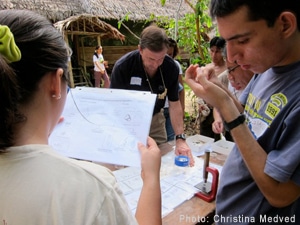
ONE MAN’S LEAF LITTER…
Back in the fall of 1966, a plethora of small mesh bags full of tree leaves suddenly began popping up in local streams in southern Chester County, Pa. No doubt, unwitting passersby shook their heads and bemoaned the increase of litter in the creeks.
In a sense, they were litter — bags of leaf litter that would become the foundation of Stroud Water Research Center’s education program starting in 1990.
Could even the visionary founders of the Stroud Center have imagined the future super stardom of those simple bags of tree leaves back in 1966 when they launched operations as a field station in a dusty loft above the Stroud family’s garage?
Now the bags are called Leaf Packs, a capitalized, copyrighted, and trademarked name that is well known to science students and watershed community activists around the world.
The procedure is simple. Place a handful of dry leaves — the staple diet of stream insects — in a mesh bag and immerse it in a stream for about a month; then study the contents in a classroom or lab. The quantity and diversity of the insects found in the bag are an excellent gauge of the health of the stream.
Leaf Pack workshops have been held not just locally but internationally, reaching as far as the tropical streams of Costa Rica and Peru (see story, below). It’s one example of education programming that complements the Stroud Center’s tropical research.
ONLINE EDUCATION RESOURCES
More recently, Leaf Pack has become part of yet another groundbreaking expansion of the Center’s education program, WikiWatershed®, now under development with the help of National Science Foundation (NSF) funding.
The brainchild of Susan Gill, the Stroud Center’s education director, and Associate Research Scientist Anthony Aufdenkampe, WikiWatershed is an online resource. It is designed to let students and citizens take a close look at and become directly involved with their own neighborhood watersheds on their computers, from home, school and in the field. And, like the famously collaborative global online wikipedia.org, wikiwatershed.org encourages citizen users to add to, update, create, and maintain the data of their watersheds online.
“This is the biggest project I’ve worked on since I’ve been here,” said Gill, who has been at the Center for five years, the first Ph.D.-level scientist to lead the education department.
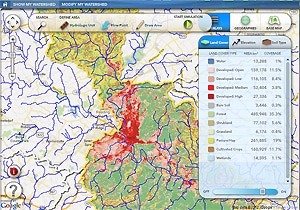
After the initial funding proposals to NSF were turned down, the Center’s team decided to break the WikiWatershed idea into several modules. The first was Model My Watershed®, which Gill said “proved to be very exciting and groundbreaking.”
The NSF panel that considered the proposal liked the idea, but as Gill found out later, the panelists thought it was impossible to do.
“Fortunately, we didn’t know we couldn’t do it,” said Gill.
The team working on the Model My Watershed® project as funded, is developing watershed-modeling tools for secondary school students. Using GoogleEarth watershed maps, students will be able to import and add data and learn to work online. The experience would be invaluable for encouraging science, technology, engineering, and mathematics careers, known by the acronym STEM.
“The project uses the complexity of environmental science to engage and excite students about the diverse STEM careers that are necessary to study and address environmental issues,” according to the Center’s education website.
Initially 25 teachers and 1,000 students in the Philadelphia area will be directly involved in the project, but the plan is for Model My Watershed® to go national and international.The existing Leaf Pack Network®, a website where students and teachers who used leaf packs to study their local stream share the data online, is a logical fit for the Model My Watershed® project.
Gill said the project is designed to get boots in the watershed and people involved and motivated to be the “eyes of the watershed.”
A GREEN BUILDING FOR ENVIRONMENTAL EDUCATION
The importance of education to the Stroud Center’s mission is affirmed by the fact that the department occupies half the space of the new building, the Moorhead Environmental Complex, which Gill said she sees as a monument to what the Center can do to communicate its science and ideas to the world.
A recent tour of the building confirms this. Though the education department takes up only half the interior space, the entire building and its surrounding landscape, parking lots, and walkways are an environmental educator’s delight.
The buildings and grounds are designed to mimic nature, a working model of the research the Center has been engaged in since its humble beginnings in the dusty loft.

Part of the exterior landscaping, designed to work like nature’s systems, are a series of created wetlands filled with native plants that do the same work as wetlands. But they are built to look like water gardens surrounded as they are by Avondale stone paths and walls. These will handle the wastewater from the building’s toilets and sinks — the building has composting and flushing toilets saving thousands of gallons of water when large groups utilize the education labs.
Stormwater from the parking lots and roofs is absorbed by permeable paving systems, a green roof, and rain gardens.
Less noticeable are the high-tech facilities for reducing energy consumption such as the geothermal heat pumps and green roof, which will increase and reduce the costs of heating and cooling by more than 35 percent. Cooling costs will also be reduced by natural ventilation. And there are solar panels, a carbon-free source of 27 percent of energy needs. There are also many windows to make use of natural light, and they are discreetly shaded to save on air conditioning.
As Christina Medved, the Center’s education programs manager and Leaf Pack Network® administrator, put it, “The new building is an education tool so that people can come here and see what they can do in their own homes and businesses.”
SHARING WHAT WE’VE LEARNED
The Stroud Center’s award-winning education department is also instrumental in many other programs including Envirothon, a partnership of conservation district associations and state, provincial, and federal natural resource agencies. The program began in 1979 in Pennsylvania as the Environmental Olympics, an inter-scholastic competition designed to get high school students interested in environmental issues. By the end of the century, it had expanded across North America, and Canon became the prime sponsor for an annual competition now called Canon Envirothon.
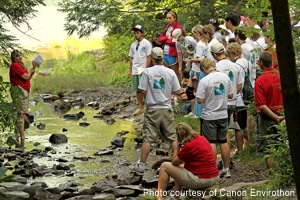
This 25th anniversary of its inception, the competition returned to Pennsylvania, and Medved traveled to Susquehanna University, with other state agency committee members, to help administer and grade the aquatics portion of the competition. This year students from Pembroke High School in Kansas City, Mo., won the Canon Envirothon.
The education department’s mission is to interpret the complex research of the scientists and pass it on to the public, through teachers and students and to citizens who volunteer to monitor the health of their local streams. Stroud educators run classes in the lab and field and organize field trips and watershed treks, like the Brandywine Trek and Mountaintop to Tap Trek which lasted for days and involved camping and paddling throughout the watershed.
The Stroud Center’s commitment to education is underscored by its prominence in the Moorhead Environmental Complex. After all, Stroud Water Research Center’s mission is two pronged: to advance our global knowledge and stewardship of freshwater systems through research and education.
Maritza: Unlocking the Secrets of Water in the Developing World
Events
Celebrating Ruth Patrick and Joan Milliken Stroud
By Diane Huskinson
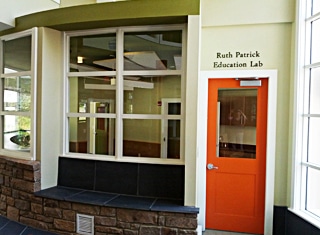
When Dr. Ruth Patrick, a pioneer in environmental research and aquatic ecology, approached Joan and Dick Stroud about creating a freshwater research laboratory on the banks of the White Clay Creek, she couldn’t have found a better matched champion of her efforts than Joan, who was an unwavering supporter of education.
Ruth envisioned a place where scientists could study, in a holistic way, the intricacies of streams and rivers to better understand matters affecting water quality. The seeds of that vision were planted in 1967 with the founding of Stroud Water Research Center.

More than four decades later, the Stroud Center opened its doors to the new Moorhead Environmental Complex, a LEED-certified “green” building for environmental education and public outreach, named in honor of Board Co-chairman Rodman W. Moorhead III for his generous support and commitment to the Center’s mission. And now, the two most prominent rooms, located in the heart of this new building, will bear the names of Ruth and Joan, whose partnership laid the foundation for the Center.
The two wings of the Complex welcome visitors upon entering the lobby: to the left, the education wing and the Ruth Patrick Environmental Lab; to the right, the public outreach wing and the Joan Milliken Stroud Conference Room.
On June 18, friends and family of Ruth Patrick and Joan Milliken Stroud gathered together for an intimate luncheon at the Complex to honor these two women for their instrumental roles in the Center’s establishment and years of success.
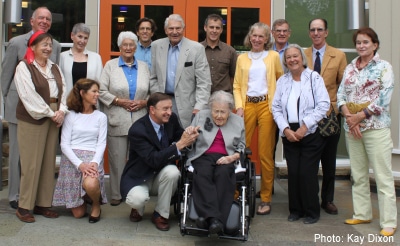
To celebrate this occasion, several generous donors, who made the naming of these two rooms possible, attended. While Joan passed away years ago, there was one very special guest of honor who did attend: Ruth Patrick, who turns 105 in November.
“We were blessed to have Ruth with us to share in such a joyful event. Because of her, the way we approach environmental science has been transformed. And thanks to her dedication as well as that of Joan and Dick Stroud and Rod Moorhead, we’re able to share our knowledge with the world,” said Director Bern Sweeney.
MEETING THE CHALLENGE
As part of the capital campaign that provides for ongoing financial needs in support of the Center’s research and education efforts, a variety of naming opportunities within the Moorhead Environmental Complex still remain:
- The education wing.
- The public outreach wing.
- The education library.
- The lobby.
- The outdoor courtyard and wetland garden area.
If you are interested in supporting the Stroud Center through one of these naming opportunities or in any other way, contact the Development Department.
In the News
Scientists Use Leaf Packs to Study Water Quality in Peru
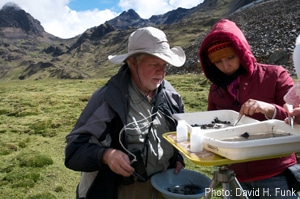
As part of a special National Geographic News series on global water issues, Ker Than for National Geographic News, reported how scientists are using leaf packs designed by Stroud Water Research Center to monitor the environmental impacts on waterways in Peru due to the new Transoceanic Highway. Read the full story, “Bugs Help Measure Impact of New Transoceanic Highway on Amazon”
Jackson Shares Value of Bugs in Evaluating Threats to Wissahickon
At a town meeting on the health of the Wissahickon Creek, a panel of environmental experts, including the Stroud Center’s John K. Jackson, Ph.D., examined numerous threats to the Wissahickon Creek. Jackson explained how bugs can be used to determine the health of a stream. Read the full story, “Climate Change May Be the New Threat to the Wissahickon Creek”
Stroud Study Cited in Devil’s Pool Story
An article by Lane Blackmer for NewsWorks on one man’s efforts to patrol Devil’s Pool, a tempting spot for vandals and swimmers alike which spills into the Wissahickon Creek, cites a 12-year study of the Schuylkill River by Stroud Water Research Center. Read the full story, “Fighting the Devil: One Philadelphia Police Officer’s Personal Mission to Patrol Devil’s Pool”
Newbold Explains Benefits of Trees for Lancaster County
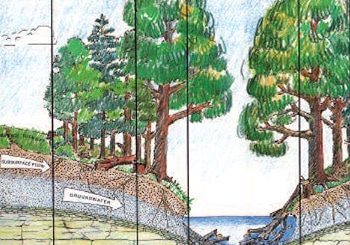
A recent report issued by Lancaster County is calling for tree plantings to beat stormwater runoff and improve water quality in local streams. Jeff Hawkes of the Intelligencer Journal/Lancaster New Era interviewed Research Scientist Denis Newbold, Ph.D., of Stroud Water Research Center to inquire about the benefits of tree coverage.
Researchers Collect Bugs to Check Pollution in Susquehanna
Stroud Water Research Center researchers collected insect samples in July to evaluate the effects of a Procter & Gamble plant on the Susquehanna River’s water quality. Patrick Leonard of The Citizens’ Voice interviewed the team. Read the full story, “Researchers Wrap Up River Tests”
Stroud Featured in The Hunt
In a sweeping profile of Stroud Water Research Center, Sarah Karpovich of The Hunt Magazine shines a light on the Stroud Center’s history, mission, and ongoing efforts. Read the full story, “Stewardship Backed by Science: The Stroud Water Research Center, World-Class Research Close to Home”
Stroud™ Scientists and Educators Present
Our scientists and educators engage in both scientific and public forums to share their findings, increase awareness, and create a public dialog centered on the protection, preservation, and restoration of watersheds everywhere. The following highlights recent presentations.
Kaplan Presents Stormy View of Organic Carbon
Lou Kaplan, Ph.D., senior research scientist and head of the biogeochemistry department, presented the seminar “Rocked and Roiled: A Stormy View of Organic Carbon Processing in a Headwater Stream Ecosystem” at the department of environmental science and engineering, University of North Carolina, Chapel Hill, in March. The seminar presented estimates of organic carbon exports during storms. Storms change water velocity and depth and can disturb microbial communities on the streambed, leading to an export of organic carbon to downstream ecosystems.
Annual Meeting of the Society for Freshwater Science
Bern Sweeney, Ph.D., John Jackson, Ph.D., and Dave Arscott, Ph.D., attended the Annual Meeting of the Society for Freshwater Science in Louisville in May. Sweeney and Jackson presented a paper and were co-authors on several presentations in a special session that focused on the application of molecular taxonomy to stream bioassessment.
Arscott and Anthony Aufdenkampe, Ph.D., organized a special session on integrating remote, real-time monitoring systems in stream and river science. Arscott presented back-to-back talks on the Stroud Center’s efforts to develop wireless environmental sensor networks using open-source electronics and deployment of a sensor that measures dissolved organic carbon and other water quality components. Arscott also co-organized a special session and was co-author on a paper on research advances and conservation challenges in temporary streams.
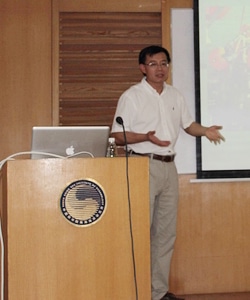
Kan Initiates Working Relationships in China
In July, Jinjun Kan, Ph.D., traveled to China to visit several institutes to present his work and initiate relationships between the Center and several institutes. He visited South China Sea Institute of Oceanology, Chinese Academy of Sciences, Sun Yat-Sen University, Ocean University of China, and First Institute of Oceanography, State Oceanic Administration. He presented seminars on topics in molecular microbial ecology and his case studies in Yellowstone Lake and the Chesapeake Bay.
Educators Give Presentation on Creating Citizen Scientists
In March, the Center’s Director of Education Susan Gill, Ph.D., and Education Programs Manager Christina Medved with their colleagues from Cabrini College, Dave Dunbar, Ph.D., and Carrie Nielsen, Ph.D., presented “Collaborative Assessment: Measuring Effects of Community-Based Participatory Research on Student Learning” at The Conference for the Scholarship of Teaching & Learning in Statesboro, Ga.
The presentation included information on undergraduate science courses for nonscience majors, with a particular focus on creating citizen scientists. These courses were a part of a project funded by the National Science Foundation. This presentation provided project background information, the educators’ approach to teaching these classes as well as strengths and weaknesses found, and advice for other institutions on incorporating participatory research into their classes.
Guardians of the Brandywine Receive Macroinvertebrate and Water Chemistry Training
In April, Stroud Water Research Center educators provided macroinvertebrate identification training to 16 individuals from the Guardians of the Brandywine, a volunteer monitoring group in Wallace Township. Participants included high school students, undergraduate and graduate students, an environmental consultant, board members from the Guardians of the Brandywine, an engineer, a videographer, and a teacher. The training included macroinvertebrate identification, proper collecting techniques, and data analysis. All participants took at pretest and posttest. Pretest scores averaged 46.17 percent while the posttest average increased to 77.22 percent.
In May, educators trained 6 individuals from the Guardians of the Brandywine in conducting water chemistry tests. They were trained in measuring dissolved oxygen, turbidity, conductivity, pH, and water and air temperature.
Leaf Pack Workshop in Gettysburg
Nine individuals participated in a two-day Leaf Pack Network® workshop which took place at Gettysburg College on June 19–20, 2012. School teachers took the workshop in efforts to better understand stream ecology and also to be introduced to a new method of sampling streams — using leaf packs.
The Franklin County Conservation District provided Leaf Pack Experiment Stream Ecology kits to each participant contingent on the completion of an implementation form that outlines how the teachers plan to incorporate this monitoring tool into their classroom.
Participants took a pre-test and post-test. Pre-test scores averaged 70 percent while the post-test average increased to 97.7 percent.
Watershed specialists from Adams and Cumberland counties as well as Pennsylvania Department of Conservation and Natural Resources foresters helped recruit and host the workshop.
Gill Presents at Association for Environmental Studies and Science Conference
In June, Susan Gill, Ph.D., attended the Association for Environmental Studies and Science Conference in Santa Clara, Ca., where she presented on developing undergraduate environmental programs. Gill proposed a holistic approach to understanding and preserving the health and integrity of the interface between human and natural systems. The presentation was based on the work of the Roundtable on Environmental Systems and Sustainability.
Medved Helps Develop Test for Canon Envirothon Competition
The 2012 Canon Envirothon Competition took place at Susquehanna University (SU) in Selinsgrove, Pa. on July 23-25. Education Programs Manager Christina Medved was on a committee, with members from throughout the state representing various state agencies, to develop the Aquatic Ecology Station test. She spent several days at SU to administer and grade the test. Envirothon started in Pennsylvania 25 years ago and became international with Canada’s involvement. Several hundred students participated in this year’s competition, with students coming from as far away as Alaska and the Yukon Territory. The Canon Envirothon competition is the largest high school environmental competition in North America.
Check Out New Stroud Videos on STEM Careers!
The Center’s environmental education/communication intern, Alicia McGlade, created four terrific videos, each highlighting an individual working within a career in science, technology, engineering, or math (STEM). The videos, part of the Model My Watershed® project, are an effort to introduce middle and high school students to STEM careers with which they may not be as familiar. These videos are now online and can be viewed at the Center’s YouTube channel. McGlade graduated with a degree in Communications from West Chester University this past May. Visit our YouTube channel
Students Name Streams, Investigate Bugs, and More With Williams
Vivian Williams, an education program manager and program design specialist with the Center, led several programs and workshops in recent months for area school groups.
Nearly 100 fifth grade students and six teachers from Media Elementary School (Media, Pa.) participated in the Stream Names Project, an educational program that emphasizes a sense of place based on a local unnamed stream. Students are challenged to suggest a stream name based on several descriptive characteristics like a landscape feature, local history, commemorative name, or a locally used common name. Students investigate and learn how to interpret topographical, hydrologic, cultural, and natural histories of the nearby stream. The chosen stream name will be submitted to USGS for official naming.
Several other programs such as Streamlines, Temperature Island Mapping, Investigating Macroinvertebrates, and the Color of Water were conducted with students at Gustine Recreation Center (Philadelphia), and the Overbrook Environmental Education Center (Philadelphia) during the Day of Science Program organized by the U.S. Forest Service at Cab Calloway School of the Arts (Wilmington, De.), and for Avon Grove Charter School at the Brandywine River Museum (Chadds Ford, Pa.).
Williams also led several workshops for educators who work or volunteer at various museums, nature centers, schools, or parks. “Dream Street: Re-visioning Your Yard,” explains the intricacies of green roofs and walls, rain gardens and rain barrels, and other innovative best management practices for managing stormwater runoff and was offered to educators near Laurel Hill (Philadelphia, Pa.) and at Wagner Free Institute of Science (Philadelphia).
A workshop titled “What Is a Watershed?” was held for the PA Master Naturalist Program at the Fairmount Water Works Interpretive Center (Philadelphia) while other topics were presented for the Trees for Tots program at the Tot Recreation Conference 2012 at the Pelbano Recreation Center (Philadelphia) and for The Land Conservancy of Southern Chester County at the Bucktoe Preserve (near Unionville, Pa.).
These programs were made possible by support from the Point Lookout Farmlife and Water Preserve Foundation (Chadds Ford) as part of The Science of Water Through the World of Art program (as well as by local support from many of the participating organizations).


